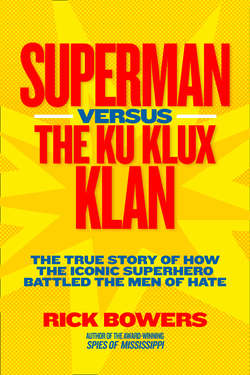Читать книгу Superman versus the Ku Klux Klan: The True Story of How the Iconic Superhero Battled the Men of Hate - Richard Bowers - Страница 17
* CHAPTER 5 * CHAMPION OF THE OPPRESSED
ОглавлениеAS THE COMIC BOOK INDUSTRY took shape in New York, Jerry and Joe were eking out a living by operating their own two-man comic business in Cleveland. The aspiring writer and illustrator were living with their parents to save on expenses, working from a makeshift studio in Joe’s attic, and working menial part-time jobs to make ends meet. Having managed to get a couple of contracts with new comic book publishers in New York, the pair developed a few interesting characters. Their title Federal Men featured a wisecracking Federal Bureau of Investigation (FBI) agent named Steve Carson who worked undercover to find kidnapped babies and shut down criminal gangs. Spooky Dr. Occult was a brash, supernatural ghost detective who tracked down zombies, vampires, and other spectral figures. In some episodes the evil Dr. Occult even donned a red cape and took flight as the creators tried out a bit of their Superman material. As the work ebbed and flowed, Jerry and Joe waited for their big break. That’s where Superman was supposed to come in.
At first Jerry insisted on holding back the Superman character from the low-paying comic book publishers in hopes of selling it to an established newspaper syndicate. A major syndicate like King Features or United Features could place a Superman strip in hundreds of newspapers nationwide and generate thousands of dollars in royalties in the process. A portion of the royalties would go to the creators week after week, month after month, year after year, for the life of the strip. Strips like Little Orphan Annie and Popeye had been popular in newspapers for years, and their creators were dining at the top of the comic-art food chain. But the strategy of saving Superman for syndication had produced only a drawer full of rejection letters from syndicate executives, who claimed that an all-powerful being from another planet, dressed in tights and serving the public good, was too far-fetched for a broad newspaper audience comprised mostly of adults. One editor from United Features indelicately summed up Superman as “a rather immature piece of work.”
Losing patience with rejections, Jerry and Joe finally sent off Superman samples to comic book publishers, only to receive more negative feedback. With no one in the publishing business showing interest in the Superman character, the Man of Steel sat on the shelf. Then, one day in the spring of 1938, Jerry and Joe opened the mail to find an intriguing proposal from DC Comics—Harry Donenfeld’s promising new venture. The letter came from editor Vin Sullivan, who had been assigned to launch a new title, Action Comics (AC), to build on the success of DC Comics. Jerry and Joe had created a couple of the lesser characters for Donenfeld’s publications, but this new one sounded bigger. Sullivan wanted a 13-page Superman adventure as the lead story for the debut issue of AC. Sullivan was desperate for a good character and didn’t have time to start from scratch with a new concept. He had come across an old, rejected Superman proposal, and he was willing to pay Siegel and Shuster to recraft it for AC—pronto. Jerry and Joe’s company would have to produce the four-color cover and 13 pages of illustrated text in a couple of weeks to meet a fast-approaching deadline.
Tired of watching their best character sit on the shelf as new comic books rolled out new superheroes every week (even the word “super” was turning up regularly), Siegel and Shuster accepted the offer and began scrambling to fill the order. After a series of back-and-forth rewrites, remakes, and spats between the Cleveland collaborators and the New York publishers, 200,000 copies of the comic went to press in the summer of 1938. Action Comics No. 1 hit the newsstands with Superman on the cover. The hero is effortlessly lifting a car as men scramble in stupefied horror.
Although the story would be embellished and refined in future editions, the first page of panels in Action Comics No. 1 lays out the superhero’s basic origins and core identity. It also reveals his decidedly liberal leanings. Superman bursts onto the scene as the New Deal blend of optimism and social responsibility, a muscular do-gooder with a boundless passion for justice. Or as Action Comics
